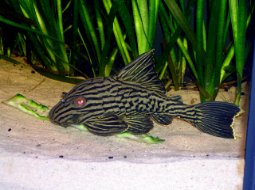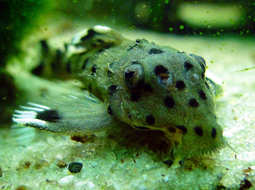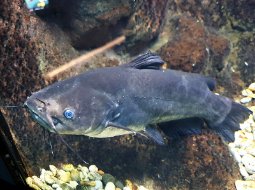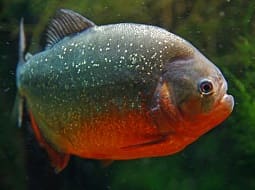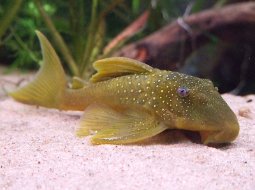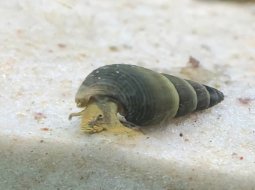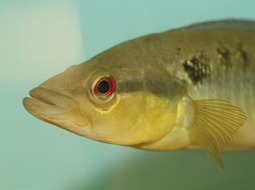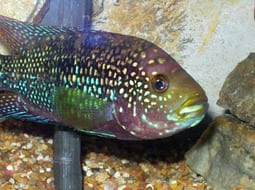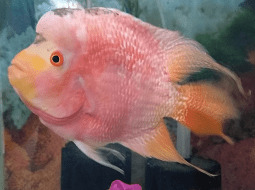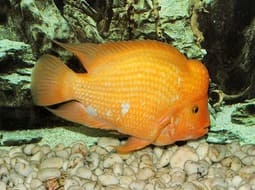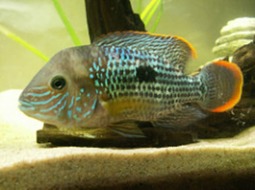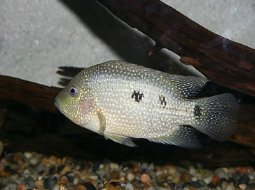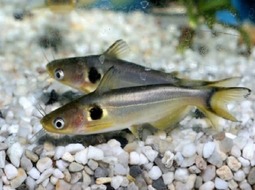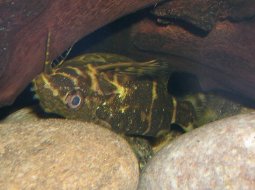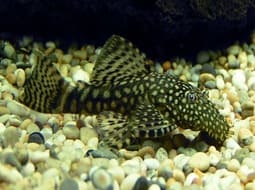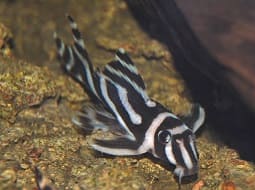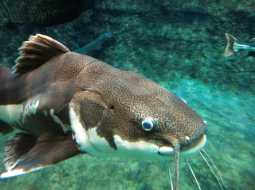
Loading Aqualapp ...
Care and Compatibility of Osteoglossum bicirrhosum - Osteoglossum bicirrhosum
Introduction
The Osteoglossum bicirrhosum, commonly known as the Arowana or Dragon Fish, is a species of freshwater fish native to South America. It is known for its elongated body and elegant appearance. It has a silver coloration with large scales and prominent fins. Its distinctive feature is its elongated jaws and barbels, which give it its name. It is a highly valued species in the aquarium trade due to its unique appearance.
Behavior
The Osteoglossum bicirrhosum is an active and predatory fish. It has excellent jumping ability and can propel itself out of the water to capture prey on the water surface. It is territorial and can display aggressive behavior towards other fish in the aquarium, especially during feeding.
Sexual Dimorphism
Sexual dimorphism in Osteoglossum bicirrhosum is minimal and difficult to distinguish. Both males and females have a similar appearance. During the breeding season, they may exhibit more pronounced territorial and courtship behaviors.
Reproduction
The Osteoglossum bicirrhosum reproduces through egg laying. They are open water spawners, which means they release their eggs into the water and do not actively care for their fry. After hatching, the fry are very vulnerable and should be raised in a separate environment to prevent them from being eaten by adults. As they grow, they develop their characteristic elongated shape and distinctive colors.
Aquarium Conditions
Osteoglossum bicirrhosum, also known as silver arowana, requires a large aquarium with plenty of space for swimming and jumping. It is a freshwater fish that prefers warm and well-oxygenated water. Aquarium décor should be minimal to allow unrestricted movement. Maintaining water quality is crucial and providing a varied diet.
Feeding
The Arowana is a carnivorous fish and feeds primarily on insects, crustaceans, small fish, and other aquatic invertebrates. In captivity, it can be offered a varied diet including live foods such as mosquito larvae, shrimps, and small fish. Frozen and commercially prepared foods containing essential nutrients for growth and health can also be used.
Complexity
Caring for Osteoglossum bicirrhosum can be challenging. They are active fish that need a large and well-maintained aquarium. They are voracious predators and can jump out of the water, so a secure tank lid is required. They require a diet rich in protein and regular water maintenance.
In case you need more help, or if you want to know into any topic related to the Osteoglossum bicirrhosum (Osteoglossum bicirrhosum) and even any other species you can use the forums to ask what you need.
To do an analysis more detailed about coexistence and behavior of Osteoglossum bicirrhosum (Osteoglossum bicirrhosum) use the Aquarium simulation tool, if you do this you can test different ways to combine the Osteoglossum bicirrhosum with other fishes giving the dimensions and space on you aquarium, on this way you can known the optimal configuration for keep the fishes that you want.
You can also find out the 27 species compatible with the Osteoglossum bicirrhosum (Osteoglossum bicirrhosum) can live together.
Note: The parameters of the water such as PH and temperature are also used to calculate the compatibility of the species.
Compatible species (27)
Compatible (5 Species)
Compatible without any restriction
Try to have hiding places at the bottom of the aquarium for bottom fish such as plecos.
Similar Sizes (2 Species)
They can coexist if they are the same size or very similar sizes, it does not work in all cases, there may be exceptions.
With Reservation (16 Species)
Compatible in some cases, it depends on the nature and personality of the fish.
Pueden llevarse bien debido a que ocupan espacios diferentes del acuario, ya que el arawana por lo general se mantiene en la parte superior/media del acuario y el pez gato sol en la parte del fondo del acuario.
Las especies territoriales por lo general pueden convivir con especies protegidas con coraza, ya que no pueden hacerles daño por su dura piel, lo que si hay que tener en cuenta es tener un acuario con dimensiones favorables para que cada pez pueda delimitar un territorio, ya que la mayoría de peces acorazados son también peces de fondo y les gusta estar buscando lugares donde ocultarse.
Considerable size difference (3 Species)
They can coexist while they are similar in size or the size difference is not very abysmal, since as the fish grows it increases the chances of eating its partner that did not grow much.
Compatible if space is enough (1 Species)
They can coexist together if the aquarium they share is large and spacious enough for both species to feel good, as some fish may attack others to feel that they have little space and try to eliminate the competition.
Osteoglossum bicirrhosum
Osteoglossum bicirrhosum

- Ph: 6.5 - 7.5
- Temperature (c°): 24 - 30
- Measures: 60 cm - 80cm
- Aquarium Capacity:
320 Liters - 85 Gallons - Alimentación: Carnivores
- Colores: Gris, White, Yellow
- Comportamiento: Territorial
- Habitad: American
- Preferencias del Acuario: Logs, Rocks
- Tamaño: Very Big
- Taxonomía: Fish
- Tipo de Agua: Sweet water
- Velocidad de nado o movimiento: Normal
- Zona de Nado: Swim in the middle of the aquarium, Swimming on aquarium surface

.jpg)

